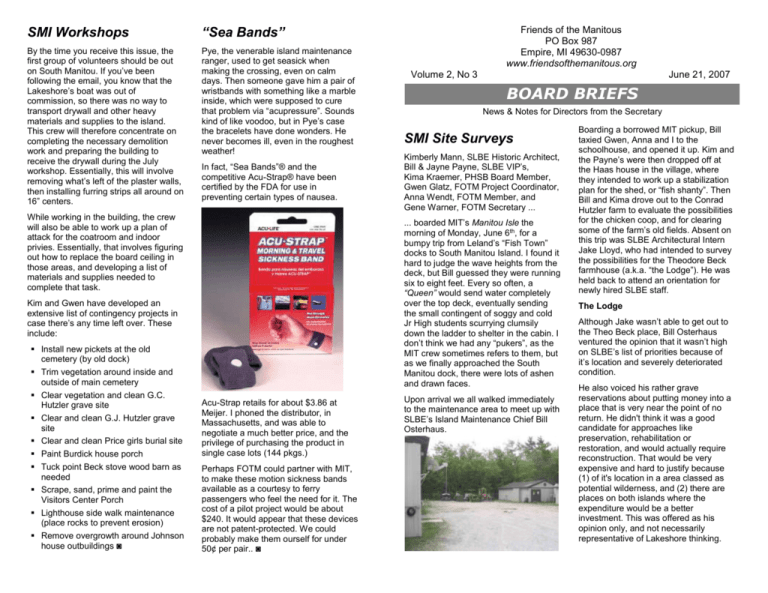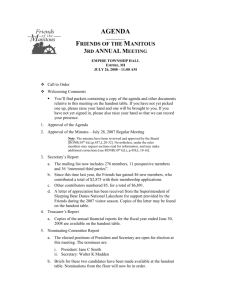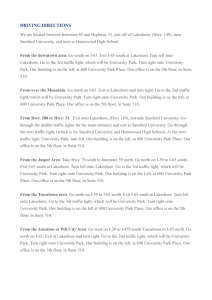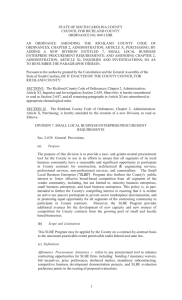newsbrief - SolutionsForSecretaries.Com
advertisement

SMI Workshops “Sea Bands” By the time you receive this issue, the first group of volunteers should be out on South Manitou. If you’ve been following the email, you know that the Lakeshore’s boat was out of commission, so there was no way to transport drywall and other heavy materials and supplies to the island. This crew will therefore concentrate on completing the necessary demolition work and preparing the building to receive the drywall during the July workshop. Essentially, this will involve removing what’s left of the plaster walls, then installing furring strips all around on 16” centers. Pye, the venerable island maintenance ranger, used to get seasick when making the crossing, even on calm days. Then someone gave him a pair of wristbands with something like a marble inside, which were supposed to cure that problem via “acupressure”. Sounds kind of like voodoo, but in Pye’s case the bracelets have done wonders. He never becomes ill, even in the roughest weather! In fact, “Sea Bands”® and the competitive Acu-Strap® have been certified by the FDA for use in preventing certain types of nausea. While working in the building, the crew will also be able to work up a plan of attack for the coatroom and indoor privies. Essentially, that involves figuring out how to replace the board ceiling in those areas, and developing a list of materials and supplies needed to complete that task. Volume 2, No 3 June 21, 2007 BOARD BRIEFS News & Notes for Directors from the Secretary SMI Site Surveys Kimberly Mann, SLBE Historic Architect, Bill & Jayne Payne, SLBE VIP’s, Kima Kraemer, PHSB Board Member, Gwen Glatz, FOTM Project Coordinator, Anna Wendt, FOTM Member, and Gene Warner, FOTM Secretary ... ... boarded MIT’s Manitou Isle the morning of Monday, June 6th, for a bumpy trip from Leland’s “Fish Town” docks to South Manitou Island. I found it hard to judge the wave heights from the deck, but Bill guessed they were running six to eight feet. Every so often, a “Queen” would send water completely over the top deck, eventually sending the small contingent of soggy and cold Jr High students scurrying clumsily down the ladder to shelter in the cabin. I don’t think we had any “pukers”, as the MIT crew sometimes refers to them, but as we finally approached the South Manitou dock, there were lots of ashen and drawn faces. Kim and Gwen have developed an extensive list of contingency projects in case there’s any time left over. These include: Install new pickets at the old cemetery (by old dock) Trim vegetation around inside and outside of main cemetery Clear vegetation and clean G.C. Hutzler grave site Clear and clean G.J. Hutzler grave site Clear and clean Price girls burial site Paint Burdick house porch Tuck point Beck stove wood barn as needed Scrape, sand, prime and paint the Visitors Center Porch Lighthouse side walk maintenance (place rocks to prevent erosion) Remove overgrowth around Johnson house outbuildings ◙ Friends of the Manitous PO Box 987 Empire, MI 49630-0987 www.friendsofthemanitous.org Acu-Strap retails for about $3.86 at Meijer. I phoned the distributor, in Massachusetts, and was able to negotiate a much better price, and the privilege of purchasing the product in single case lots (144 pkgs.) Perhaps FOTM could partner with MIT, to make these motion sickness bands available as a courtesy to ferry passengers who feel the need for it. The cost of a pilot project would be about $240. It would appear that these devices are not patent-protected. We could probably make them ourself for under 50¢ per pair.. ◙ Upon arrival we all walked immediately to the maintenance area to meet up with SLBE’s Island Maintenance Chief Bill Osterhaus. Boarding a borrowed MIT pickup, Bill taxied Gwen, Anna and I to the schoolhouse, and opened it up. Kim and the Payne’s were then dropped off at the Haas house in the village, where they intended to work up a stabilization plan for the shed, or “fish shanty”. Then Bill and Kima drove out to the Conrad Hutzler farm to evaluate the possibilities for the chicken coop, and for clearing some of the farm’s old fields. Absent on this trip was SLBE Architectural Intern Jake Lloyd, who had intended to survey the possibilities for the Theodore Beck farmhouse (a.k.a. “the Lodge”). He was held back to attend an orientation for newly hired SLBE staff. The Lodge Although Jake wasn’t able to get out to the Theo Beck place, Bill Osterhaus ventured the opinion that it wasn’t high on SLBE’s list of priorities because of it’s location and severely deteriorated condition. He also voiced his rather grave reservations about putting money into a place that is very near the point of no return. He didn't think it was a good candidate for approaches like preservation, rehabilitation or restoration, and would actually require reconstruction. That would be very expensive and hard to justify because (1) of it's location in a area classed as potential wilderness, and (2) there are places on both islands where the expenditure would be a better investment. This was offered as his opinion only, and not necessarily representative of Lakeshore thinking. Bill was also concerned about the building being structurally unsound, and therefore an unsafe environment for volunteer workers. The Hutzler Chicken Coop; Recovering Farm Fields Kima photographed the chicken coop, which, as you can see, is indeed in need of major reconstruction. Some of the existing materials laying around the site can be reused, but it will most likely be necessary for Kim to produce more rough-sawn lumber from the CCC forests found in the Lakeshore. The historic fields around the farm will be cleared using Lakeshore tractors and possibly some other some heavy equipment PHSB will bring over to the island. Volunteers will provide manual labor. Thereafter, Glen Arbor-based Cherry Republic will take over the maintenance of the fields, as their corporate public service project. To refresh your memory, these graves were identified by the Lakeshore’s Kevin Kelly, on a hand-drawn map he made of the cemetery. Late last year, Kimberly Mann suggested it would be appropriate for the Friends to place markers, in order to preserve their sanctity. Unfortunately, nobody has come forward with any information as to who might be buried in them. Rumor has it that they contain the remains of black men ... possibly loggers, or cholera victims from a passing ship. Under the circumstances, the traditional FOTM crosses would probably not be an appropriate marker. Engraved rocks were considered, but simple vertical granite slabs, engraved with the word “Unknown”, would probably be more authentic, given the probable burial date. I’ve spent a lot of time trying to come up with such stones, without any luck. More recently, I happened across some quarries that produce granite slabs for use as stair treads, and these would probably be pretty close to what we had in mind. Now I need to find a place that would be willing to sell or donate two. one of the Lakeshore’s many CCC plantings, and having them milled to suit. It’s a good use of the non-native timber, which the Lakeshore plans to remove eventually anyway. At this point, the costs would be limited to the milling fees, which should come in well below the $600 previously given as a rough estimate. Johnson House Outbuildings Just for the sake of interest, Kim and the Paynes struggled into the jungle behind the Johnson House in search of a privy that had been part of that unit. The privy was located, found basically intact, but well hidden in overgrowth. Interestingly, it has a window behind the “throne” that roughly faces the lighthouse. The Haas Shed As a bonus, another structure, evidently a workshop, was also found in the overgrown outback. Island maintenance chief Bill Osterhaus, suggested that clearing away some of the growth would “Unknown” Grave Mrakers The group also made a quick trip out to the cemetery to have a look at the two unmarked burial sites. They were found where expected ... two well-defined grave-size depressions just outside the gate. One lies perpendicular, and immediately adjacent to, the fence. The other lies nearby, approximately parallel to, and about six to eight feet away from, the fence. Both have the remnants of what appear to have been decorative plantings. The Haas shed is in much better shape than the Hutzler chicken coop. In fact, the shed, as is, is rather picturesque. Kimberly Mann and the Paynes have been working up a plan, and it would appear that little is needed by way of materials and supplies, except some rough-sawn lumber. Kim provides that by harvesting “exotic” pine frees from be a good side project for our volunteer crew. Kim feels that the privy can be repaired, and would make a good project. She’s not as sure about the shed. ◙ Lighthouse Repairs Continue Lakeshore maintenance specialist Bill Love and a colleague are working on the South Manitou Lighthouse, tuck pointing as necessary, and repainting the tower. At the time of our visit, the top had been painted, and the area from the deck up had been tuck pointed and made ready for painting. Naturally, while the work is going on, the lighthouse will not be open to visitors, and to obviate the necessity for re-rigging every week, it will also be closed over the weekends until the work is done. That will probably be late in the summer. On Thursday, the 16th, Paul and I went to Drummond Island for the annual meeting of the DeTour Reef Light Preservation Society. On the way, we paid a visit to BM1 Kris Nyland, the ATON Petty Officer at the St Ignace Station, which is responsible for the Crib between North and South Manitou. Among other things, Kris showed us the Vega unit typically used for incandescent installations, and explained how the fully automated installation works. With respect to someday re-lighting the South Manitou light, I’ve always been concerned with power drain, since the South light was a steady white signal. It turns out that the Vega unit works on a 100% duty cycle (on all the time). Moreover, the solar array on the Crib, which is not massive, simultaneously operates a back up light, the fog signal and the RACON (beacon transponder.) Re-lighting the South Manitou lighthouse might therefore not be such a big technical challenge. ◙







